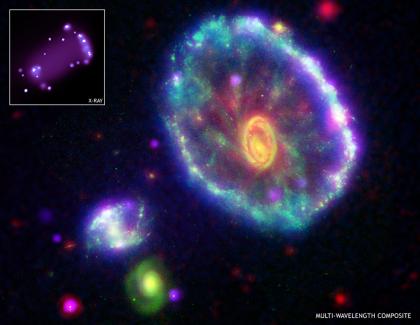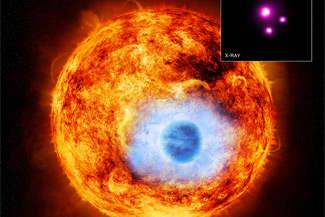2013. 8. 9. 12:19ㆍ별 이야기
Cartwheel Galaxy:
Astronomers Do Flips Over Cartwheel Galaxy

Credit: Composite: NASA/JPL/Caltech/P.Appleton et al. X-ray: NASA/CXC/A.Wolter & G.Trinchieri et al.
This image combines data from four different observatories: the Chandra X-ray Observatory (purple); the Galaxy Evolution Explorer satellite (ultraviolet/blue); the Hubble Space Telescope (visible/green); the Spitzer Space Telescope (infrared/red). The unusual shape of the Cartwheel Galaxy is likely due to a collision with one of the smaller galaxies on the lower left several hundred million years ago.
The smaller galaxy produced compression waves in the gas of the Cartwheel as it plunged through it. These compression waves trigger bursts of star formation. The most recent star burst has lit up the Cartwheel's rim, which has a diameter larger than that of the Milky Way galaxy, with millions of bright young stars.
When the most massive of these stars explode as supernovas, they leave behind neutron stars and black holes. Some of these neutron stars and black holes have nearby companion stars, and have become powerful sources of X-rays as they pull matter off their companions.
The brightest X-ray sources are likely black holes with companion stars, and appear as the white dots that lie along the rim of the X-ray image. The Cartwheel contains an exceptionally large number of these black hole binary X-ray sources, because many massive stars formed in the rim.
The Beautiful Universe: Chandra in HD
High definition views of Chandra's exciting science

Subscribe and automatically download fresh audio/video content: View content online by clicking the "View Podcast" links below (requires QuickTime 7.0 or other H.264-compliant video viewer. If videos do not play, right click or control click on the link to download the file to your hard drive & then open). Or, subscribe to the podcast using a program such as iTunes or ipodder with the podcast RSS/XML web address (listed below).

NASA's Chandra Sees Eclipsing Planet in X-rays for First Time
- Dowload Video Podcast (129.4 MB, Runtime: 2:37)
- Listen to Audio only
- Transcript
- Related Links:
-- NASA's Chandra Sees Eclipsing Planet in X-rays for First Time


Stars like the Sun can become remarkably photogenic at the end of their life.
- Dowload Video Podcast (115.9 MB, Runtime: 2:57)
- Listen to Audio only
- Transcript
- Related Links:
-- A Beautiful End to a Star's Life


Astronomers estimate that a star explodes as a supernova in our Galaxy, on average, about twice per century.
- Dowload Video Podcast (115.3 MB, Runtime: 2:37)
- With closed-captions (at YouTube)
- Listen to Audio only
- Transcript
- Related Links:
-- The Remarkable Remains of a Recent Supernova


Many consider Andromeda, also known as Messier 31, to be a sister galaxy to our own Milky Way.
- Dowload Video Podcast (105.1 MB, Runtime: 2:27)
- With closed-captions (at YouTube)
- Listen to Audio only
- Transcript
- Related Links:
-- Black Hole Bonanza Turns up in Galaxy Next Door
-- Tour of M31


While most of us use electricity every day without thinking about it, maybe take a moment to look around.
- Dowload Video Podcast (106.5 MB, Runtime: 4:11)
- With closed-captions (at YouTube)
- Listen to Audio only
- Transcript
- Related Links:
-- Here, There, and Everywhere


A magnetar is a type of neutron star that occasionally generates bursts of X-rays.
- Dowload Video Podcast (70.8 MB, Runtime: 2:10)
- With closed-captions (at YouTube)
- Listen to Audio only
- Transcript
- Related Links:
-- A Hidden Population of Exotic Neutron Stars
-- Tour of SGR 0418+5729


Astronomers think that just about every galaxy contains a giant, or supermassive, black hole at their center.
- Dowload Video Podcast (76.6 MB, Runtime: 2:18)
- With closed-captions (at YouTube)
- Listen to Audio only
- Transcript
- Related Links:
-- Black Hole Powered Jets Plow Into Galaxy
-- Tour of 4C+29.30


There are patterns of beauty across our Earth and throughout the Universe.
- Dowload Video Podcast (59.4 MB, Runtime: 2:48)
- With closed-captions (at YouTube)
- Listen to Audio only
- Transcript
- Related Links:
-- From the Earth to the Heaven


Most of us have heard the story of the tortoise and the hare. The tortoise is slow and the hare is fast. But what exactly does this mean?
- Dowload Video Podcast (72.5 MB, Runtime: 2:59)
- With closed-captions (at YouTube)
- Listen to Audio only
- Transcript
- Related Links:
-- STOP for Science


Two large galaxies are colliding and scientists have used Chandra to make a detailed study of an enormous cloud of hot gas that surrounds them.
- Dowload Video Podcast (133 MB, Runtime: 2:49)
- With closed-captions (at YouTube)
- Listen to Audio only
- Transcript
- Related Links:
-- Colossal Hot Cloud Envelopes Colliding Galaxies
-- Tour of NGC 6240

'별 이야기' 카테고리의 다른 글
| 초질량 블랙홀, 은하계에서 무더기 발견 / 서울신문 기사 (0) | 2013.09.11 |
|---|---|
| "보이저 1호, 1년여 전 태양계를 떠났다"/ 연합 기사 (0) | 2013.08.17 |
| 120억년 전 우주의 빛을 파헤치다 / CBS뉴스 (0) | 2013.08.07 |
| [스크랩] 인류가 달에 처음 닿은 날. (0) | 2013.06.12 |
| 나비를 닮은 성운 ㅡ 날개폭만 3광년 (0) | 2013.06.10 |